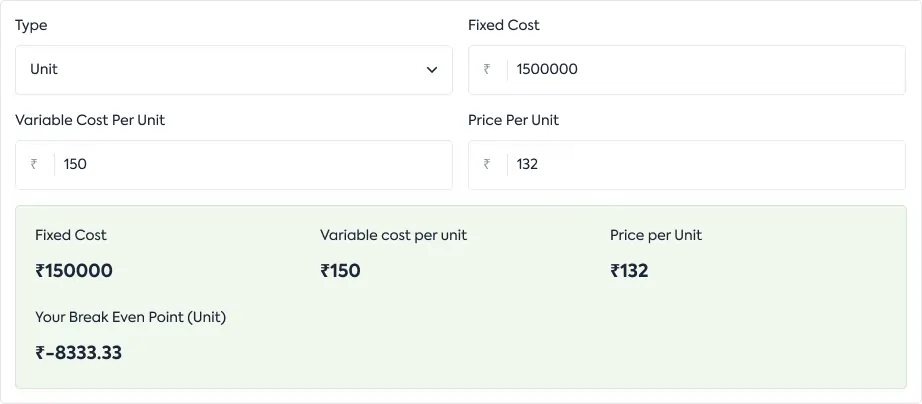Grab a chance to avail 6 Months of Performance Module for FREE
Book a free demo session & learn more about it!
-
Will customized solution for your needs
-
Empowering users with user-friendly features
-
Driving success across diverse industries, everywhere.
Grab a chance to avail 6 Months of Performance Module for FREE
Book a free demo session & learn more about it!
Superworks
Modern HR Workplace
Your Partner in the entire Employee Life Cycle
From recruitment to retirement manage every stage of employee lifecycle with ease.


Seamless onboarding & offboarding
Automated compliance & payroll
Track performance & engagement

Break-Even Point (BEP) Calculator: A Tool for Financial Analysis
Break-Even Point (BEP) Calculator is a financial tool used by businesses to determine the level of sales necessary to cover all costs and achieve a net income of zero. It helps businesses assess the minimum level of activity required to avoid losses and transition into profitability. This guide aims to explain the purpose of a BEP Calculator, how it works, key considerations, and the benefits it offers.
What is a Break-Even Point (BEP) Calculator and its Purpose?
A Break-Even Point (BEP) Calculator is a tool designed to calculate the level of sales needed to cover all fixed and variable costs, resulting in zero net income. Its purpose is to help businesses identify the minimum sales volume or revenue required to cover operating expenses and reach the break-even threshold.
How does a Break-Even Point (BEP) Calculator Work?
Users input specific details such as fixed costs, variable costs per unit, and selling price per unit into the BEP Calculator. The calculator then computes the break-even point by dividing total fixed costs by the contribution margin per unit, providing a measure of the sales volume needed to cover all costs.
Key Considerations in Break-Even Point (BEP) Calculation:
-
Fixed Costs:
The expenses that remain constant regardless of the level of production or sales, such as rent, salaries, insurance premiums, and depreciation.
-
Variable Costs per Unit:
The costs that vary with the level of production or sales, such as raw materials, direct labor, and sales commissions, expressed on a per-unit basis.
-
Selling Price per Unit:
The price at which a product or service is sold to customers, which influences the revenue generated from each unit sold.
Make better financial decisions with Superworks
Benefits of Using a Break-Even Point (BEP) Calculator:
-
Profitability Assessment:
The calculator helps businesses assess their financial viability by determining the level of sales required to cover all costs and achieve breakeven.
-
Decision Making:
By analyzing the break-even point, businesses can make informed decisions regarding pricing strategies, cost control measures, production planning, and investment opportunities.
-
Risk Management:
Understanding the break-even point enables businesses to identify potential risks and uncertainties, such as changes in costs or market conditions, and develop contingency plans to mitigate these risks.
Example of Break-Even Point (BEP) Calculation:
Suppose a company has fixed costs of $50,000, variable costs per unit of $20, and a selling price per unit of $50. Using the BEP Calculator, the break-even point is calculated as Fixed Costs / (Selling Price per Unit – Variable Costs per Unit), resulting in a break-even point of 2,500 units.
Break even point questions and answer
1. What is a break-even analysis?, and why is it important to calculate?
The break-even point represents the level of sales at which total revenue equals total costs, resulting in zero net income. It is crucial for businesses as it indicates the minimum sales volume needed to cover operating expenses and transition into profitability.
2. How does changes in fixed costs, variable costs, and selling price affect the break-even point?
An increase in fixed costs or variable costs will shift the break-even point higher, requiring a higher level of sales to cover the increased expenses. Conversely, a decrease in fixed costs or variable costs will lower the break-even point. Similarly, an increase in the selling price per unit will reduce the break-even point, while a decrease in the selling price will increase it.
3. Can the break-even point be used to assess the financial risk associated with a business venture?
Yes, the break-even point provides valuable insights into the financial risk of a business venture by indicating the level of sales needed to cover costs and avoid losses. A higher break-even point implies greater financial risk, as the business requires higher sales volumes to achieve profitability.
4. What factors should businesses consider when interpreting the break-even point results?
Businesses should consider factors such as market demand, competition, pricing dynamics, and sales forecasting accuracy when interpreting break-even point results. Additionally, it is essential to assess the sensitivity of the break-even point to changes in costs and sales volumes to understand the business’s resilience to fluctuations in market conditions.
5. How often should businesses reassess their break-even point, and what are some strategies for improving it?
Businesses should regularly reassess their break-even point to reflect changes in costs, pricing strategies, market conditions, and business objectives. Strategies for improving the break-even point include cost reduction initiatives, increasing sales volumes through marketing and sales efforts, enhancing operational efficiency, and diversifying product offerings to increase revenue streams.
A Break-Even Point (BEP) Calculator is a valuable tool for businesses to assess their financial performance and make informed decisions about pricing, cost management, and revenue generation. By calculating the break-even point, businesses can identify their minimum sales targets and develop strategies to achieve profitability and sustainable growth.
